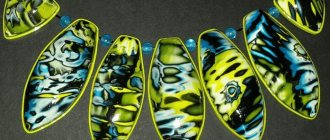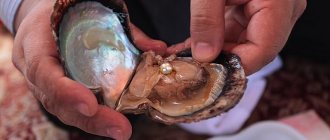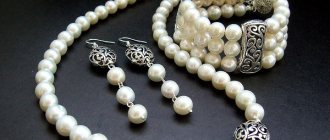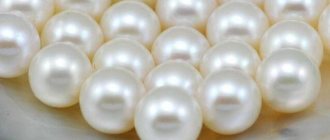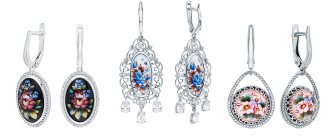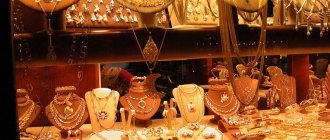Mokume Gane is a Japanese metalworking technique that has been around for at least 300-400 years. Its name consists of several Japanese words: “mo” - wood, “kume” - texture, “gane” - metal. It can be translated into Russian as “metal similar to wood.” Actually, the essence of the technique is to create a metal product, the surface of which imitates the pattern of tree bark.
Rings using mokume gane technique, author - Pavel Helennar, Russia
Technique: fold but do not mix
This method of metal processing was developed in the 17th century by the Japanese master Denbei Shoami (1651-1728). He created exclusive katanas for samurai, decorating their handles and blades with wood patterns. The pedigree of mokume gane “from weapons” is not surprising: the art of making swords in medieval Japan was so complex that it dictated the development of all other types of metal processing.
The technology has not changed dramatically since then. Sheets of metals of different colors are still layered on top of each other repeatedly and then sintered under pressure and high temperatures to form a new crystalline structure. It sounds simple, but in reality the master has a thousand and one opportunities to stumble. If the melting point is too high, the layers of metals will merge into one mess. If it’s too low, they won’t stick together. Moreover, metals can change their color when heated, which also complicates the work.
The layers connected under the influence of temperature are subjected to various kinds of mechanical influences, and depending on the type of influence, a different pattern is obtained. For example, blanks are twisted to obtain a twisted “wood” pattern; or a hole is made in the briquette blank and pressed (with a press, sledgehammer or rollers) until it is flattened, and the pattern eventually “turns” outward, distributed over a plate of uniform thickness. A pattern, like fingerprints, makes an item unique.
To create objects using the mokume gane technique, skill and experience are required, imagination and a willingness to experiment are a must, but you also cannot do without special equipment. Jewelers often use muffle furnaces to create their objects, although the “forge” approach, originally used in the creation of ancient edged weapons, is not uncommon. Some photos and videos of the process of creating products using the mokume gane technique can be seen, for example, in the account of one of the world's leading experts, James Binnion.
Coloring page[edit]
To increase the contrast between laminate layers, many mokume-gane pieces are painted by applying a patina (a controlled layer of corrosion) to highlight or even completely change the color of the metal's surface.
Patination of niiro and rokusho[edit]
One example of traditional Japanese patinas for Mokume-gane is the use of the niiro process, usually involving rokushō, a complex Copper Verdigris compound prepared specifically for use as a patina. The piece to be patinated is prepared, then immersed in a boiling solution until it reaches the desired color, and each element of the composite piece may be painted a different color. Historically, a paste of crushed daikon radish was also used to prepare the work for patina. The paste is applied immediately before cooking the product in rokusho to protect the surface from tarnishing and uneven coloring. [5]
Materials for Mokume Gane
Traditionally, soft metals are used for mokume gane: gold, copper, silver. However, this list never ceases to expand: yellow, pink and white gold, bronze, platinum, titanium claim their place in a work of art. You can learn more about the properties of the listed metals in our catalog of jewelry metals.
The main materials for this Japanese technology can be divided into 4 groups: copper and its alloys, silver and alloys, gold and alloys, and platinum group metals. Malleable and bright copper is traditionally the basis of mokume gane products. For a long time, Japanese craftsmen used an alloy of gold and copper, called “shakudo,” and an alloy of copper and silver was called “shabuichi.”
Since 2005, there has also been a titanium version of mokume gane - the innovative patented alloy Titanium Damascus (Timaskus) - you can read more in Russian here, in English - here. Despite all the advantages of titanium technology (no corrosion, lightness, no magnetization), it is unlikely that it will be possible to make a product from this material in an ordinary jewelry workshop: the process will require forging, special machines, presses and an understanding of technology using inert gases.
Links[edit]
- Midgett, Steve (2000). Mokume Gane Comprehensive Study
. earthy press. ISBN 0-9651650-7-8. - "Blog article by Mokume Gane". Larsen Jewelry
. 2016. Retrieved April 8, 2016. - ^ abc "About Mokuma Ghana". Andrew NYCE Designs
. 2002. Retrieved February 10, 2015. - ^ B s d e e Binnion, J. E. & Chaix, B. (2002). "Old process, new technology: modern Mokume Gane". Archived from the original (PDF) on August 29, 2009. Retrieved January 26, 2007. Cite journal requires |journal= (help)
- ^ abc Pijanowski, H. S. & Pijanowski, G. M. (2001). "Wood-Grained Metal: Mokume-Gane". Retrieved January 26, 2007. Cite journal requires |journal= (help)
- Loring, John (2001). Magnificent Tiffany Silver
. Harry N. Abrams. ISBN 0-8109-4273-9.
Who is doing what in Japanese technology today?
As time passed, the need for a large number of katanas disappeared. Mokume gane began to be used to create ordinary, everyday things: vases, dishes and other things. Three centuries later, technology expanded the geography of its presence and conquered Western markets. Europeans appreciated the potential of “wood metal” and began to include it in jewelry. Rings, necklaces and bracelets made using this technique are very expensive, just like katanas in their time, and the real hit (which we, frankly, would like to diversify) are “layered” wedding rings with a unique texture, for each couple newlyweds with their own unique design.
At the moment, mokume gane can be included in the jewelry “red book”. Few brave people dare to master such a complex technique at a professional level. And selling finished products is quite difficult: the gap between the incomes of the population and the elite is constantly growing; Few people, both abroad and in Russia, can afford such luxury. A separate problem is that it is still not entirely clear how to mark mixed precious metals with an assay mark with an established hallmark. Rare masters who develop in the sphere of the “real”, without compromises and simplifications, mokume gane, are even more valued.
World experts in mokume gane technique
Foreign jewelers James Binnion, George Sawyer Studio, Jaume Labro and others are known for their work in this technique. Some of them closely follow Japanese traditions, others, like Mike Sakmar, create their own variations of familiar designs. Here are some links to foreign famous experts.
James Binnion (James Binnion Metal Arts), USA
@james_binnion_metal_arts, website mokume-gane.com
Jim's biography (in texts about himself he refers to himself as Jim, not James) includes 9 years of experience serving in the American submarine fleet as an electronics specialist, as well as experience as a research engineer in the field of electronics. For over 35 years, Jim has been researching and teaching mokume gane techniques, specializing as a jeweler in creating diamond engagement rings and more. One of his areas of work in the field of materials is Damascus steel.
Anne Wolf, USA
@annevillestudio, website annevillestudio.com
Anne is another recognized expert in mokuma gan, and in addition to creating jewelry, she is very active in teaching this technique.
Steven Jacob
@stevenjacobjewelry, mokume.com
Stephen and Jacob's father-son workshop specializes in Damascus steel and mokume gane wedding rings.
Ryuhei Sako, Japan
@ryuheisako, website sakoryuhei.com
The decorative art objects of this Japanese master are intended to remind you that this technique has no limits in its implementation.
Art objects using the mokume gane technique by the Japanese master Ryuhei Sako, photo from the site www.sakoryuhei.com
Carlos Godoy, Brazil
Facebook facebook.com/mokdesign.STORE, website mok.com.br
Carlos was born in 1964 and lives in Sao Paulo, Brazil (see post in the Decoration group). In South America he is the main authority on the mokume gane technique.
Jewelers specializing in mokum gan, in Russia and the post-Soviet space
In the post-Soviet space, mokume gane is promoted by the workshop of Pavel Helennar, the artel of TAU workshops (@mikhail_zlatar), the Kochut brand and others.
Dmitry Kuznetsov, Novosibirsk
@alcedo_jewelry, website silver-lab.ru
Dmitry Kuznetsov creates original handicrafts - works of art in a variety of techniques; mokume gane is a separate area.
Pavel Helennar, Moscow
@helennar, shop at the “masters fair” livemaster.ru/helennar
Pavel has been working purposefully in the Mokume Gane technique for a long time, creating unusual wedding rings (including those with precious stones) and other types of jewelry.
Semyon Shapovalenko, Nizhny Novgorod
@_mokumegane_, website mokumejewel.ru
Semyon began his creative journey by recreating copies of ancient Japanese swords, and since 2014 he has been independently studying the mokume gane technique, trying to find his own separate style in both design and materials.
Brand Kochut (Ukraine)
@kochut_jewelry, website jewelery.kochut.org/shop/mokume
The Kochut brothers combine different shades of gold using the mokume gane technique with gems, creating very impressive color combinations.
Andrey Seginovich, Koan Jewelry, Ukraine
@koan_jewelry, etsy shop etsy.com/shop/KoanJewelry
Andrey creates works in the art and avant-garde style not only in classic mokume gan materials, but also in titanium. For example, 3 types of titanium and gold (inside) were used to make the wedding rings below.
Not to be confused with pseudo Mokume
The concept of “mokume gane” at one time actively “went to the people.” When searching for the name of the technique, search engines come up with something “mokume style” in the first row - most often hardening polymer clay or metal clay. Craftsmen layer the materials layer by layer and sinter them, resulting in an unusual and orders of magnitude more affordable product than a classic item made using the mokume gane technique. The Crafts Fair will offer you some pretty nice things, but in the end, of course, it’s up to you to decide.
There are also quite a lot of techniques that seem to be real, but a very simplified approach to creating jewelry and other objects using this famous Japanese technique. In some cases they “save” on the number of layers, in others they add solders and other ways to make the task easier. Understanding whether the “mokume” in front of you is real will come with experience and observation - we advise you to subscribe to the accounts of the masters we mentioned and use every opportunity to touch the work with your own hands.
The most important
Okay, now it's time for some fun. You need to press the texture into the clay stack. This action will mix all the layers and create a pattern. You can use cutters, texture stamps, and molding tools. Anything will do.
Once you've pressed down your texture, you'll want to smooth the stack back out to cover any holes you might have made. Then you need to walk over the layers of polymer clay with an acrylic roller.
All. You can cut off thin layers and make blanks with a very interesting and original design and assemble them into the intended work of art.
Good luck everyone!
Where to find out more and where to learn
While in the West there are reliable schools where jewelers are taught the intricacies of mokume gane technology, and the craftsmen themselves (see above) often give master classes, in Russia, unfortunately, it is not easy to obtain the necessary skills. Jewelers should rely on foreign groups, textbooks, rare and random courses based on educational sites, and mainly on their own enthusiasm.
The main source of knowledge for today is the book by Steve Midgett, Mokume Gane, A Comprehensive Study (free online version), supplemented by the world's leading experts.
You can also search online for the Russian translation of the book Steve Midgett, Mokume Gane
International facebook group for mokume gane.
International Facebook group on mokume gane for professionals - here jewelers exchange the intricacies of technology.
The editors of the Jewelryum portal would like to thank the artist, sculptor, jewelry designer who works with titanium and studies various metal techniques Valery Seredin @valeri_seredin for consultations during the preparation of this article.
Catalog section Jewelry techniques and styles | All publications in the Styles and Techniques section
